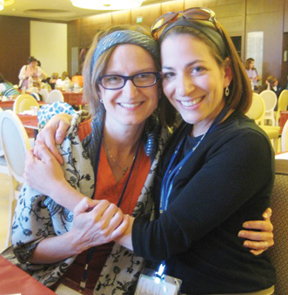Coming home
(Editor’s note: On Friday, Sept. 6, Rabbi Arthur Nemitoff gave the sermon on Shabbat Shuvah at Congregation Beth Torah at the invitation of Rabbi Mark Levin. Rabbi Levin had spoken at The Temple, Congregation B’nai Jehudah two years earlier on Shabbat Shuvah. Following services, several people suggested The Chronicle publish an article about the speech, however The Chronicle does not cover events on Shabbat. Instead The Chronicle is publishing Rabbi Nemitoff’s remarks, provided by the rabbi, in their entirety.)

Rabbi Arthur Nemitoff
Tonight’s message is simple. I have three goals. First I want to address the meaning of this Shabbat, Shabbat Shuvah, this Sabbath of turning. Second I want to address what it means that we gather here tonight, the significance of two congregations that truly share one history. Third, I want to address the future of the North American Jewish community. And I hope to do all that in about 10 minutes.
* * *
“The entire world is a narrow bridge and the essential piece is that we not be afraid.” Those words were uttered by Rabbi Levin at Selichot, when he spoke on reflections of forgiveness in his own life. Rabbi Shuval-Weiner used those same words on Erev Rosh Hashanah. And I use them again tonight. Those words do not belong to any of us. They belong to Rabbi Nachman of Bratzlov. Anybody who does any Jewish singing knows those words. We sing them in Jewish camps. We teach them in religious school. The question is what do they mean? “The entire world is a narrow bridge, a very narrow bridge — the essence, the key piece to remember is not to be afraid.”
Tonight is Shabbat Shuvah, the Sabbath of Shuvah, of return. What does the word “shuv” mean? “Shuvah” means repentance but “shuv” means to turn, to return. Yet, there is a problem. When you think about Rabbi Nachman’s statement that the entire world is a narrow, narrow bridge, how do you turn on a narrow bridge? It is so narrow you can’t go anywhere. Maybe what “shuv” means is not to return but to renew, to look behind to what was, to figure out where you are today, and determine where you want to go.
When folks study Rabbi Nachman’s famous quote, they ask about the narrowness of that bridge — if you go to the left, to the right you fall off, and they focus on the fear of falling. However, they forget to ask the question, “Where does the bridge come from and where does the bridge go?”
I believe that the bridge is a bridge from the earth to the heaven. Or put another way, one end of the bridge keeps us chained down and the other end leads to what allows us to soar beyond our own imaginations. This Shabbat is an opportunity to consider where we have been; but more importantly, where we want to go. Fear keeps us stuck at one end of the bridge. On this Shabbat Shuvah, the Shabbat of renewal, we know we can reach toward the other end.
* * *
When I came home 10 years ago, quite honestly one of the things that was foremost in my mind was Congregation Beth Torah. The reason why? While I was gone, Beth Torah came into existence. When I left B’nai Jehudah, Beth Torah didn’t exist. Rabbi Levin was rabbi at B’nai Jehudah. And when Beth Torah was formed, I stand here tonight to tell you something that all of us know: a wound was opened in this community, a wound that has taken 25 years to heal.
But I was thinking about Beth Torah and asking how do we heal this wound? What was the stumbling block? What I knew existed and what I felt when I came here: Fear. I don’t know what the fear was about but there was fear and there was anger and there was angst and it existed and was palpable. I recalled Rabbi Nachman’s quote, “the essential piece is not to be afraid.” Franklin Delano Roosevelt famously stated, “The only thing to fear is fear itself.” Fear gets us stuck in bad places. So, I asked: How can we go beyond the fear? Because, in the end, we all look alike, we all dress alike, we all sing the same tunes, we pray out of the same prayer book — we are the same. How to heal that wound and how to allow two congregations, each in and of itself, noble and filled with goodness … how to bring them together and allow them to work in a way that benefits themselves and the community? Rabbi Nachman reminds us, fear is the one essential ingredient that must be absent in order for us to soar.
* * *
The third element I would like to address is: What is the future of the Jewish Community in North America? I will tell you this: Rabbi Levin and I have the exact same vision of the Jewish community. In an amazing conversation that I wish each of you could have experienced, with Rabbi Larry Hoffman and the boards of B’nai Jehudah and of Beth Torah at B’nai Jehudah, he and I sat in chairs facing each other and had a dialogue. And in that dialogue, we acknowledged the fact that we were pursuing the exact same goal, albeit in opposite ways. Mine was to approach it from an individual perspective, to have each individual walk their own Jewish path. His was that there be a communal conversation. Yet, in the end, the goal was exactly the same. And at that moment, I knew what the future of the Jewish community could look like.
And now I am going to make two statements that may seem crazy, that may seem frightening, that may ask you whether or not we are at earth or in heaven but I will make them nonetheless:
The Jewish community of the future will only exist if we do things together. It is time we stop talking about B’nai Jehudah and Beth Torah and Beth Shalom and K.I. and New Reform and start talking about the Jews.
We have fewer resources, we have less people, we have greater needs. It is time for us as a community to stop being tied down to the old, to stop looking back, to stop being afraid and to look forward. It is time to figure out ways we can conserve our resources, to take the best that each of us offers and give it to one another. If we don’t do that, we will fail. Oh we will still exist. We’ll sputter along and we’ll say “O, woe is us!” and we will not thrive.
Shabbat Shuvah is time for us to look toward the future. Yes, we need to ask ourselves who we have been. But much more importantly, we should ask what can we become when we become “at one” with those around us, with ourselves, with God? I am here to say to us tonight it is time for us to be at one, to figure out how to work together, not to be a part, not to work at odds, not to see each other as competition but to see each other as partners. As I walked into the building tonight, I saw three things that I wished B’nai Jehudah could do, could be better at. I wasn’t jealous, I was inspired. I hope that when you walk into B’nai Jehudah there are one or two things that will inspire you, as well.
On the morning of Sukkot, our two congregations will be praying together. It has never happened before, has it? We are going to be outside in our sukkah. We are going to be together. You know our ancestors made pilgrimage to Jerusalem on the holidays, they are called the “shalosh regalim” for a purpose ... “regalim” means pilgrimage. In the past, our ancestors went to Jerusalem from wherever they lived. They joined together and they prayed to God. We, too, are going to be together.
I pray that what began two years ago emerges into something transformational for our community. Rabbi Levin and I have had conversations. We have collaborated in a few areas, but I pray tonight will be the jumping off point … a point where we no longer look behind us but rather look ahead of us and ask, “What can we do as a community, together?”
It is time for us to no longer be afraid. The entire world is this narrow bridge and there is only one direction for us to go if we want to succeed. The secret is to not be afraid. On Rosh Hashanah morning, my sermon was titled “What If” and I spoke about the “what ifs” of life, the negatives and the positives. I conclude my remarks tonight by asking a “what if” — What if our two congregations — all of our congregations — got rid of their fears (and there are many kinds of fears that we have) and we sat down together and dreamed of what the future could look like together?
… And then together we made that happen.
What if?
I end by quoting Tom Clancy. Tom Clancy once said that the two questions that have to be asked of every novel writer are “what if?” and “what next?” So I ask tonight, what if our leadership, our clergy, our members were brave enough to sit down together. What if? I would like to see what’s next.






